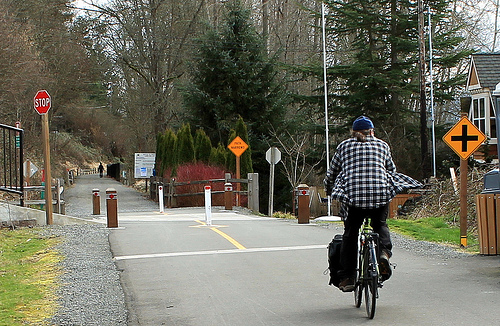On March 10, 2014, the U.S. Supreme Court decided a rails-to-trails case, ruling in favor of the private property owners. The case of Marvin M. Brandt Revocable Trust et al. v. United States hinged on whether the rights-of-way granted under the General Railroad Right-of-Way Act of 1875 were easements or something more, such as a “limited fee with an implied reversionary interest.”
As many of you know, we work on some of the rails-to-trails cases across the United States. This is not a huge chunk of our business, but perhaps 1% to 2% of our revenues annually come from this very visible line of work. And two of our client law firms were part of this case (on the winning side), and in particular, Thor Hearne of Arent Fox, for whom we’ve worked on several of these cases.
In short, when a railroad abandons a rail line, the right-of-way ownership may revert to the adjacent property owner. This all depends on whether or not the railroad had an easement (most common) or owned the land in fee-simple (rare). In either case, the federal government often wants to reclaim the right-of-way for railbanking and, as an interim use, will transfer the possession (but not ownership) of the right-of-way to a local entity who will often develop a hiking or biking trail.
Our neck of the woods is replete with these railbanked projects—the Lake Sammamish line (from Issaquah to Redmond) or parts of the Burke-Gilman Trail are prime examples. A recent case involved the abandoned line along the east side of Lake Washington, from Renton to Woodinville. We consulted on some of that. If the right-of-way was only an easement (and that right-of-way had some of both), then according to a Supreme Court ruling quite a few years ago, the U.S. Government can take the land but has to pay the adjacent property owners for the take. Many of these acquisitions get very complicated and require the services of a complex valuation firm such as ours.

Photo of the East Lake Sammamish Trail courtesy of Gene Bisbee.
Anyway, some of these old rail lines have titles that weren’t terribly clear. A lot of this title work was done back in the 1800s, and the railroads and the government never really considered the abandonment of the easement. In the Brandt case, the Brandt family obtained their Wyoming property in a deal with the U.S. government in 1976, but the property had a rail line running through it that dated from the 1800s. The railroad abandoned the line, and there was scant information in the title about reversion of the easement back to the Brandts.
Well, last month in an 8-1 decision (with Justice Sotomayor dissenting), the U.S. Supreme Court ruled in favor of the property owners that the U.S. Government needs to value the easement taken and pay the Brandts fair market value for their interests. The court held that according to the previous decision in Great Northern R. Co. v. United States, 315 U. S. (1942), the 1875 Act granted “only an easement, and not a fee.” Once a railroad company abandons such an easement, the easement is extinguished and full control of the underlying land reverts to the landowner.
This decision clarifies a number of these cases which have been hanging out there, and it may lead to our involvement in several new cases going forward.
– John Kilpatrick





Recent Comments